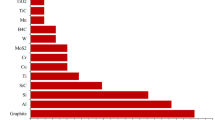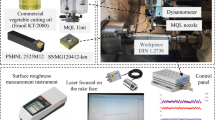Abstract
Recent trends in metal cutting shows the increasing of demand at the global stage for the application of eco-friendly machining approaches in order to eliminate the adverse effects of conventional cutting fluids. Thus, this experimental work was conducted to evaluate the performance of sustainable cooling techniques of cryogenic carbon dioxide (CO2), Minimum Quantity Lubrication (MQL), cryogenic liquid nitrogen (LN2) and dry cutting on machinability of Inconel 718. For the cryogenic CO2 approach, a new concept of cryogenic cooling technique was introduced for efficient and consistent cooling performance. The findings displayed cryogenic CO2 as a promising coolant since it resulted in slower tool wear rate compared to cryogenic LN2 and dry cutting, while being more effective in decreasing cutting forces and surface roughness compared to other approaches. Its adequate and consistent cooling efficiently disperses the generated heat and creates an ideal cutting condition for the tool and workpiece to interact with each another during cutting. In contrast to MQL cutting, the usefulness of CO2 was supplanted due to the resulting shorter tool life. As such, the MQL approach is preferred as it extends the tool life longer by 67.2% with the maximum volume of material removal as compared to cryogenic CO2. Its lubrication impact shows effectiveness in diminishing the tool wear rate than the cooling effect by the cryogenic CO2. However, from the viewpoint of sustainability, MQL could be less preferable due to unpleasant odour and settling of MQL mist around the cutting area.














Similar content being viewed by others
References
Shokrani, A., Dhokia, V., & Newman, S. T. (2012). Environmentally conscious machining of difficult-to-machine materials with regard to cutting fluids. International Journal of Machine Tools and Manufacture,57, 83–101.
Lawal, S. A., Choudhury, I. A., & Nukman, Y. (2012). Application of vegetable oil-based metalworking fluids in machining ferrous metals–a review. International Journal of Machine Tools and Manufacture,52(1), 1–12.
Debnath, S., Reddy, M. M., & Yi, Q. S. (2014). Environmental friendly cutting fluids and cooling techniques in machining: a review. Journal of Cleaner Production,83, 33–47.
Debnath, S., Reddy, M. M., & Pramanik, A. (2018). Dry and near-dry machining techniques for green manufacturing”, Innov. Manuf. Sustain. Mater. Forming. Innovations in Manufacturing for Sustainability,1, 9–11.
Devillez, A., Le Coz, G., Dominiak, S., & Dudzinski, D. (2011). Dry machining of Inconel 718, workpiece surface integrity. Journal of Materials Processing Technology,211(10), 1590–1598.
Musfirah, A. H., Ghani, J. A., & Haron, C. H. C. (2017). Tool wear and surface integrity of Inconel 718 in dry and cryogenic coolant at high cutting speed. Wear,376–377, 125–133.
Shokrani, A., Dhokia, V., Newman, S. T., & Imani-Asrai, R. (2012). An initial study of the effect of using liquid nitrogen coolant on the surface roughness of Inconel 718 nickel-based alloy in CNC milling. Procedia CIRP,3(1), 121–125.
Faga, M. G., Priarone, P. C., Robiglio, M., Settineri, L., & Tebaldo, V. (2017). Technological and sustainability implications of dry, near-dry, and wet turning of Ti-6Al-4 V alloy. International Journal of Precision Engineering and Manufacturing-Green Technology,4(2), 129–139.
Park, K. H., Yang, G. D., Lee, M. G., Jeong, H., Lee, S. W., & Lee, D. Y. (2014). Eco-friendly face milling of titanium alloy. International Journal of Precision Engineering and Manufacturing,15(6), 1159–1164.
Kaynak, Y. (2014). Evaluation of machining performance in cryogenic machining of Inconel 718 and comparison with dry and MQL machining. International Journal of Advanced Manufacturing Technology,72(5), 919–933.
Pereira, O., Rodriguez, A., Fernandez-Abia, A. I., Barreiro, J., & Lopez de Lacalle, L. N. (2016). Cryogenic and minimum quantity lubrication for an eco-efficiency turning of AISI 304. Journal of Cleaner Production,139, 440–449.
Kasim, M. S. (2014). Prestasi Perkakas Pemotong Karbida Bersalut Semasa Pengisaran Inkonel 718 Dalam Keadaan Kuantiti Pelincir Minimum.Universiti Kebangsaan Malaysia.
Wang, Y., et al. (2018). Processing characteristics of vegetable oil-based nanofluid MQL for grinding different workpiece materials. International Journal of Precision Engineering and Manufacturing-Green Technology,5(2), 327–339.
Madhukar, S., Shravan, A., Vidyanand, P., & Reddy, G. S. (2016). A critical review on minimum quantity lubrication (MQL) coolant system for machining operations. International Journal of Current Engineering,6(5), 1745–1751.
Badroush, N., Haron, C. H. C., Ghani, J. A., Azhar, M. F., & Halim, N. H. A. (2018). Performance of coated carbide tools when turning Inconel alloy 718 under cryogenic condition using RSM. Journal of Mechanical Engineering,5(3), 73–87.
Bagherzadeh, A., & Budak, E. (2018). Investigation of machinability in turning of difficult-to-cut materials using a new cryogenic cooling approach. Tribology International,119, 510–520.
Pereira, O., Rodríguez, A., Barreiro, J., Fernández-Abia, A. I., & de Lacalle, L. N. L. (2017). Nozzle design for combined use of MQL and cryogenic gas in machining. International Journal of Precision Engineering and Manufacturing Technology,4(1), 87–95.
Kopač, F. (2016). Sustainability assessment : cryogenic machining of Inconel 718. Journal of Mechanical Engineering,57, 637–647.
Pusavec, F., et al. (2016). Analysis of the influence of nitrogen phase and surface heat transfer coefficient on cryogenic machining performance. Journal of Materials Processing Technology,233, 19–28.
Aramcharoen, A., & Chuan, S. K. (2014). An experimental investigation on cryogenic milling of Inconel 718 and its sustainability assessment. Procedia CIRP,14, 529–534.
Iturbe, A., Hormaetxe, E., Garay, A., & Arrazola, P. J. (2016). Surface integrity analysis when machining Inconel 718 with conventional and cryogenic cooling. Procedia CIRP,45, 67–70.
Patil, N. G., Asem, A., Pawade, R. S., Thakur, D. G., & Brahmankar, P. K. (2014). Comparative study of high speed machining of Inconel 718 in dry condition and by using compressed cold carbon dioxide gas as coolant. Procedia CIRP,24, 86–91.
Machai, C., & Biermann, D. (2011). Machining of β-titanium-alloy Ti–10 V–2Fe–3Al under cryogenic conditions: cooling with carbon dioxide snow. Journal of Materials Processing Technology,211(6), 1175–1183.
Cordes, S., Hübner, F., & Schaarschmidt, T. (2014). Next generation high performance cutting by use of carbon dioxide as cryogenics. Procedia CIRP,14, 401–405.
Pereira, O., et al. (2012). The use of hybrid CO2 + MQL in machining operations. Procedia Engineering,132, 492–499.
Dilip, Jerold B., & Pradeep, Kumar M. (2012). Experimental comparison of carbon-dioxide and liquid nitrogen cryogenic coolants in turning of AISI 1045 steel. Cryogenics (Guildf),52(10), 569–574.
Çakır, O., Kıyak, M., & Altan, E. (2004). Comparison of gases applications to wet and dry cuttings in turning. Journal of Materials Processing Technology,153, 35–41.
Hardmetal, S. E. (2015). Sumitomo General Catalog,2015–2016, 1–45.
Hadi M. B. A. (2016). Pencirian dan analisa pemesinan laju tinggi kriogenik menggunakan mata alat kisar hujung bebola bersalut karbida ke atas Inkonel 718. Universiti Kebangsaan Malaysia.
2 ISO (1989). Tool life testing in milling—Part 2: End milling.
Alauddin, M., Mazid, M. A., El Baradi, M. A., & Hashmi, M. S. J. (1998). Cutting forces in the end milling of Inconel 718. Journal of Materials Processing Technology,77(1–3), 153–159.
Kasim, M., et al. (2018). Investigation of tangential force on ball nose rake face during high-speed milling of Inconel 718. Advanced Materials Processing Technologies,0698, 1–7.
Courbon, C., Pusavec, F., Dumont, F., Rech, J., & Kopac, J. (2013). Tribological behaviour of Ti6Al4V and Inconel 718 under dry and cryogenic conditions—Application to the context of machining with carbide tools. Tribology International,66, 72–82.
Liang, X., Liu, Z., & Wang, B. (2018). State-of-the-art of surface integrity induced by tool wear effects in machining process of titanium and nickel alloys: A review. Measurement,132, 150–181.
Kaynak, Y., Karaca, H. E., Noebe, R. D., & Jawahir, I. S. (2013). Analysis of tool-wear and cutting force components in dry, preheated, and cryogenic machining of NiTi shape memory alloys. Procedia CIRP,8, 498–503.
Mia, M. (2017). Multi-response optimization of end milling parameters under through-tool cryogenic cooling condition. Measurement: Journal of the International Measurement Confederation,111, 134–145.
Pusavec, F., Hamdi, H., Kopac, J., & Jawahir, I. S. (2011). Surface integrity in cryogenic machining of nickel based alloy—Inconel 718. Journal of Materials Processing Technology,211(4), 773–783.
Kaynak, Y., Lu, T., & Jawahir, I. S. (2014). Cryogenic machining-induced surface integrity: A review and comparison with dry, MQL, and flood-cooled machining. Machining Science and Technology,18(2), 149–198.
Thakur, A., & Gangopadhyay, S. (2016). State-of-the-art in surface integrity in machining of nickel-based super alloys. International Journal of Machine Tools and Manufacture,100, 25–54.
Sandvick. (2017). Cutting tool wear - wear on cutting edges. Retrieved January 16, 2017 from http://www.sandvik.coromant.com/en-gb/knowledge/materials/cutting_tool_materials/wear_on_cutting_edges.
Ginting, A., Skein, R., Cuaca, D., Herdianto, Pieter, & Masyithah, Z. (2018). The characteristics of CVD- and PVD-coated carbide tools in hard turning of AISI 4340. Measurement: Journal of the International Measurement Confederation,129, 548–557.
Kasim, M. S., et al. (2016). Cost evaluation on performance of a PVD coated cutting tool during end-milling of Inconel 718 under MQL conditions. Transactions of the Institution of Metal Finishing,94(4), 175–181.
Acknowledgements
Acknowledgement is given to the Government of Malaysia and Universiti Kebangsaan Malaysia for providing the research fund (Grant No: UKM-DIP-2017-023), tools, material, equipment, and support with the technical solutions.
Author information
Authors and Affiliations
Corresponding author
Additional information
Publisher's Note
Springer Nature remains neutral with regard to jurisdictional claims in published maps and institutional affiliations.
Rights and permissions
About this article
Cite this article
Abdul Halim, N.H., Che Haron, C.H. & Abdul Ghani, J. Sustainable Machining of Hardened Inconel 718: A Comparative Study. Int. J. Precis. Eng. Manuf. 21, 1375–1387 (2020). https://doi.org/10.1007/s12541-020-00332-w
Received:
Revised:
Accepted:
Published:
Issue Date:
DOI: https://doi.org/10.1007/s12541-020-00332-w




